Add this eBook to your basket to receive access to all 143 records. Our indexes include entries for the spelling tisdall. In the period you have requested, we have the following 143 records (displaying 31 to 40): These sample scans are from the original record. You will get scans of the full pages or articles where the surname you searched for has been found. Your web browser may prevent the sample windows from opening; in this case please change your browser settings to allow pop-up windows from this site. Traders and Merchants in London
(1791)
The Universal British Directory was published in five volumes, starting in 1791. The professions included in the London section are very diverse: the addresses are mostly from central London. Some are marked 'F. M.', meaning Freeholder of Middlesex. | Sample scan, click to enlarge
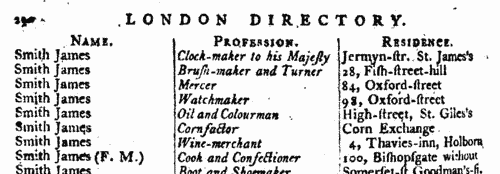
| Sackville papers
(1685-1799)
R. B. Knowles of the Historical Manuscripts Commission was invited by Mrs Stopford-Sackville to examine her family papers at Drayton House in Northamptonshire; and after his death the work was continued by W. O. Hewlett and published in 1904. These were chiefly letters, reports and other official documents from and to lord George Sackville, the third son of Lionel first duke of Dorset. The papers edited in this volume relate to the Monmouth insurrection 1685-1686; letters of Mary princess of Orange to lady Mary Forester; Sackville family papers and letters 1706-1799; home affairs 1755-1784; letters from lord George to General Irwin 1761-1784; Ireland 1731-1783; the war of the Austrian Succession 1743-1748; Cherbourgh and St Malo 1758; the Seven Years War 1758-1759; Minden 1759-1760; Spain 1778-1780; prince William Henry duke of Gloucester 1771-1779; India 1776-1784; and Minorca 1776-1782. | Sample scan, click to enlarge

| Inhabitants of Dublin
(1805)
Holden's Triennial Directory of 1805 to 1807 included a provincial section, listing professional people and traders in England, Wales, Scotland and Ireland. (The sample scan here is from the listing for Bath) | Sample scan, click to enlarge
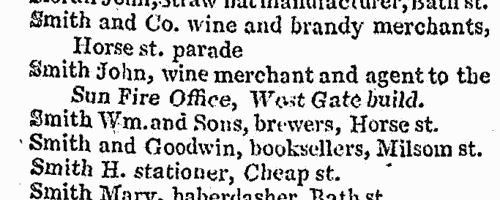
| London city aldermen and officials
(1805)
The city of London already comprised a smaller area than London as a whole. The city was governed by the Lord Mayor and aldermen. Each aldermen represented a ward, but also had to be a citizen, i. e., a member of a city company. The aldermen, their wards and companies, and the deputies and common council of the respective wards, with their occupations and addresses are listed in Holden's Triennial Directory of 1805 to 1807. This list also covers the members of the various committees involved in governing the city, governors of city institutions, and local government officials and officers. | Sample scan, click to enlarge

| Traders and professionals in London
(1805)
Holden's Triennial Directory for 1805 to 1807 includes this 'London Alphabet of Businesses, Professions, &c.': coverage is good; about 30,000 individuals are recorded. | Sample scan, click to enlarge

| Deaths, Marriages, News and Promotions
(1816)
Death notices and obituaries, marriage and birth notices, civil and military promotions, clerical preferments and domestic occurrences, as reported in the Gentleman's Magazine. Mostly from England and Wales, but items from Ireland, Scotland and abroad. July to December 1816.
| Sample scan, click to enlarge
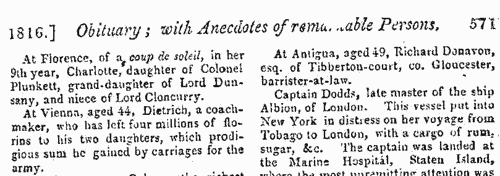
| Officers of the 4th Royal Veteran Battalion
(1820)
The War Office issued regular notices of promotions and appointments within the British Army, and these were published in the Edinburgh Gazette. Full names of these officers are given, as well as the surnames of those whose places they filled because of promotion, resignation, death, dismissal or exchange. January to December 1820. | Sample scan, click to enlarge
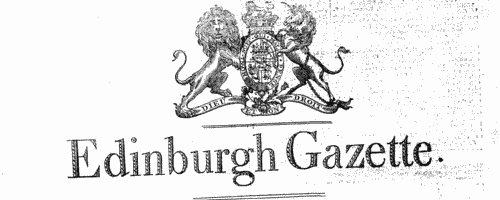
| Irish Clergy and Gentlemen Discountenancing Vice
(1822)
The Association Incorporated for Discountenancing Vice and Promoting the Knowledge and Practice of the Christian Religion had an extensive membership in Ireland, of which this list was published as the 13th appendix to a Sermon preached before the members and their president, the Lord Lieutenant, in St Peter's church by Charles R. Elrington, D. D., his chaplain. The list gives each member's full name, surname first, with the year of admission to the society. This index also covers the fourteenth appendix, listing the members' subscriptions received in 1821, but some for previous years' arrears as far back as 1817, and whether paid in diocesan committees or in Dublin. Most of the members were gentlemen or clergy. | Sample scan, click to enlarge
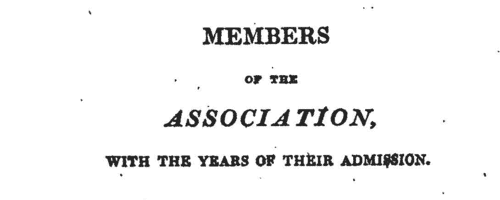
| Masters of Merchantmen
(1822)
The Society for the Registry of Shipping was instituted in 1760, and published an annual register and supplement. The annual register consisted of an alphabetical list of ships surveyed for insurance in Britain and Ireland, together with an alphabetical supplement. The society maintained a Registry Office at which alterations and additions were notified, and members delivering their registers when called for had them updated and returned on the following or the ensuing day. Each ship was given a number within each letter of the alphabet: ships' names were not unique, so within each name a ship was identified by the name of the captain or master at the time of the last survey. Then abbreviations indicate the type of vessel (Bg, brig; Bk, barque; Cr, cutter; Dr, dogger; G, galliott; H, hoy; K, ketch; S, ship; Sk, smack; Sp, sloop; Sr, schooner; St, schoot; Sw, snow), and whether sheathed (s) and/or doubled (d) with copper (C) and iron bolts (I B) or over boards (W & C), patent felt (P F), copper fastened (c f), copper bolted (c b), or copper repaired (C rp) sometimes with a date, such as (18)18. The third column, reserved for masters' names, is not particularly wide; with short surnames, an initial will be given; but longer surnames omit the initials, and even longer surnames are abbreviated. It will be borne in mind that these are the names of the masters not (necessarily) in 1822, but at the time of the last survey. Often new masters had been appointed by the time of re-survey, and their names are added in slightly smaller type under the original master's names in the third column. In the fourth column is the tonnage: where there is a blank under the number this indicates that the ship had two decks; more often the letters S D (B) for single deck (with beams); D W for deep waist; S D W single deck with deep waist; B D W single deck with beams and deep waist. Underneath the entry may run references to recent repairs: Cl. clincher built; Drp. damages repaired; grp. good repair; len. lengthened; lrp. large repair; N. (new) B. bottom, D. deck, Kl. keel, Sds. sides or UW. upper-works; rb. rebuilt; rsd. raised; Srprs. some repairs; or trp. thorough repair. In italics, the timber of the ship is described - B. B., black birch; C., cedar; H., hazel; Hk., hackmetack; J., juniper; L. O., live oak; M., mahogany; P., pine; P. P., pitch pine; S., spruce; W. H., witch hazel; W. O., white oak. The fifth column gives the place that the ship was built. For foreign ships this may be as vague as 'Dutch' or 'French'; but nothing in this record specifically indicates the nationality of ship, master or owners, except that an A. under the owner's name indicates that the vessel was American property. The sixth column gives the year of the ship's age; a few were still sailing after 30 or 40 years. The seventh column gives the owner's name, abbreviated in the same way as the master's name. Where the master was the owner, the word Capt. will appear. With vessels owned abroad, the name in this column is sometimes that of the port of origin, not the surname of the owner. Where there has been a change of owner by the time of re-survey, the new name is put underneath in smaller type. The printer sought to avoid confusion by aligning names of ports to the left and surnames to the right, but that leaves longer names doubtful. The eighth column gives the feet of the draught of water when loaded. The ninth column shows the destined voyage for which the survey took place, with the port of survey abbreviated (Be., Belfast; Br., Bristol; Co., Cork; Cs, Cowes; Da., Dartmouth; Du., Dublin; Eh, Exmouth; Ex., Exeter; Fa., Falmouth; Gr., Greenock; Hl, Hull; Hn, Harrington; La., Lancaster; Lh, Leith; Li., Liverpool; Lo., London; Ly., Lynn; Mt., Maryport; Po., Poole; Ph, Portsmouth; Pl., Plymouth; Sc., Star-Cross; Tn., Teignmouth; Tp., Topsham; Wa., Waterford; Wn, Whitehaven; Wo., Workington; Ya., Yarmouth), and the letter C where the vessel was a constant trader between the two ports. The tenth column gives the classification of the vessel (A, first; E, second) and its stores (1, first; 2, second) and the year of survey, e. g. 09 for 1809, or, if surveyed during 1821, the month, e. g. 3 for March. Where the vessel has been re-surveyed, the classification letter and number will be repeated or revised in the final column. The sample scan is from the main list. This is the index to masters in the main list and the supplement. | Sample scan, click to enlarge

| Deaths, Marriages, News and Promotions
(1828)
Death notices and obituaries, marriage and birth notices, civil and military promotions, clerical preferments and domestic occurrences, as reported in the Gentleman's Magazine. Mostly from England and Wales, but items from Ireland, Scotland and abroad.
| Sample scan, click to enlarge

|
Research your ancestry, family history, genealogy and one-name study by direct access to original records and archives indexed by surname.
|











